Learn to speak fluent Spanish and express yourself like a native when you use these words, which look the same, but are not. Today we are going to learn words in Spanish that sound the same or are spelled the same, but mean different things. They are the homonyms.
Sometimes, without noticing, I make two mistakes in English in my emails. The first is between two English words: knew and new. They sound the same! And when I am writing to one of my students or to an English-speaking friend, sometimes I get these two words mixed up.
The second mistake I make is a bit worse 😂. It is with one word in English and one word in Spanish. This only happens to me when I’m very tired: I confuse the article “the” with the preposition “de”. They sound the same too!
These are two examples of homophones, words that sound similar but have different meanings. And as you can see, it is common to make these mistakes. The good thing is that if you have these doubts, it means that you have an intermediate or advanced level of Spanish.Thus, learn to speak fluent Spanish and don’t let it happen to you like it does to me. Keep reading the article to find out how to differentiate and recognize these words, which can sometimes be quite a challenge.
Homonyms are words that sound the same or are spelled the same, but mean different things and have different etymological origins.
There are two types of homonyms:
Go ahead! Learn to speak fluent Spanish by reading the meanings and examples of these twelve homophones.
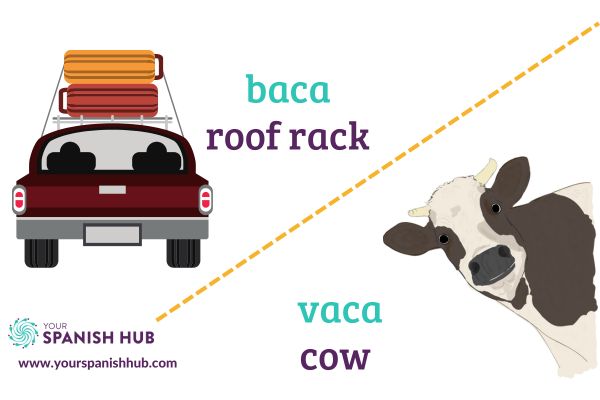
Baca: portaequipajes (roof rack). Voy a poner la maleta grande en la baca del coche.
Vaca: animal, hembra del toro (cow). Cuando viajamos a Asturias vimos muchas vacas por el campo.
Baya: fruto (berry). Me gustan mucho las bayas silvestres: las grosellas, las moras, los arándanos…
Vaya: subjuntivo del verbo ir (go, went). El viernes voy a estar muy cansada. No creo que vaya al concierto.
Bello: bonito (beautiful). Hemos visto un atardecer muy bello.
Vello: pelo corporal (body hair). Antonio quiere hacerse la depilación láser porque tiene mucho vello en el pecho.
Callado: participio del verbo callar (silent, quiet). ¿Qué te pasa? Estás muy callado hoy. ¿Te encuentras bien?
Cayado: bastón generalmente de madera (wooden staff). El pastor guía a las ovejas por el campo con su cayado.
Grabar: registrar sonidos o vídeos (record). Me gusta grabar los vídeos de mis clases por las mañanas.
Gravar: pagar impuestos (tax). El gobierno va a grabar la adquisición de algunas mercancías a partir de enero.
Hay: forma impersonal del verbo haber (there is, there are). ¿Hay alguna farmacia por aquí cerca?
¡Ay!: interjección. ¡Ay! Se me ha olvidado el móvil en casa.
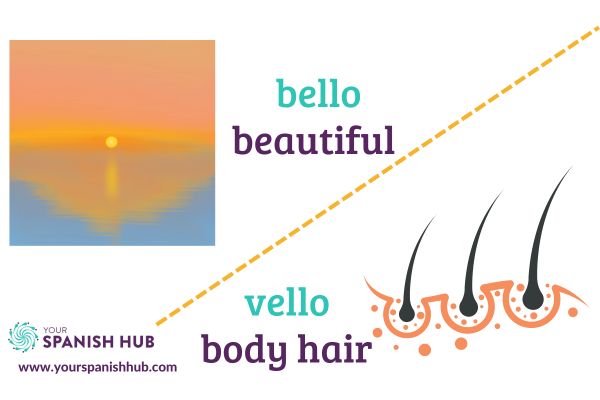
Hecho: participio del verbo hacer (done, made). ¿Has hecho ya los deberes de español?
Echo: presente del verbo echar. Añadir (add). Normalmente no le echo azúcar al café. Sólo le echo un poco de leche.
Hola: saludo (hello). ¡Hola! ¿Qué tal estás? ¡Cuánto tiempo sin verte!
Ola: onda marina (wave). Es muy relajante escuchar el sonido de las olas.
Hora: tiempo (hour). ¿Qué hora es?
Ora: presente del verbo orar. Rezar (pray). El monje ora en silencio en la capilla del monasterio.
Onda: forma fluida (wave). Tienes unas ondas muy bonitas en el pelo.
Honda: profunda (deep). Ten cuidado si nadas en la charca. Es un poco honda.
Rallar: desmenuzar (grate). Tienes que rallar un poco de limón para hacer la tarta.
Rayar: estropear una superficie (scratch). Si limpias el coche con ese estropajo, lo vas a rayar.
Rebelar: sublevar (rebel, revolt). Las condiciones de trabajo son muy malas. Me temo que los trabajadores se van a rebelar.
Revelar: hacer visible una película fotográfica (print a photo). El sábado por la mañana voy a ir a la tienda para revelar unas fotos.
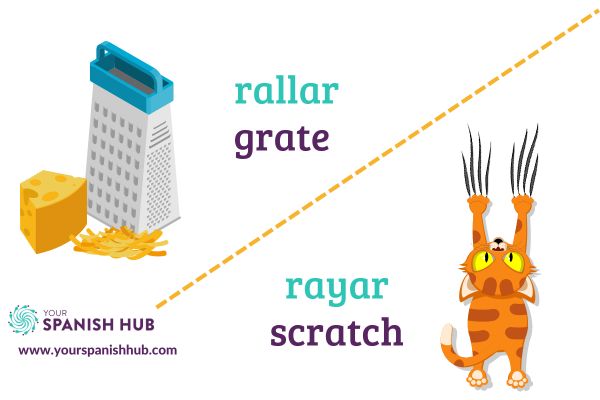
The homophones that we have seen before are very tricky especially when it comes to writing them. They are classic examples of many misspellings. For you to see an anecdote, last week, a friend who was travelling through the north of Spain sent me a postcard. In it, she said: “Te hecho de menos (I miss you).” This is incorrect, it is another example of the use of hecho – echo in the expression “echar de menos (miss someone or something)”, which is written without h.
Homographs are kinder from a spelling standpoint. Here there is no risk of typing mistakes.
Learn to speak fluent Spanish by reading the meanings and examples of these twelve homographs.
Amo: presente del verbo amar (love). Amo a mi familia y a mis amigos.
Amo: dueño (owner). El amo de perro lo cuida bien.
Botones: mozo de hotel (bellman). El botones nos ayudó a subir las maletas a nuestra habitación.
Botones: piezas para abrochar ropa (buttons). He comprado una blusa azul que tiene los botones amarillos.
Canal: cadena de televisión (TV channel). ¿En qué canal ponen la película? En la BBC.
Canal: conducto artificial para conducir el agua (channel). El agricultor ha hecho algunos canales de riego pequeños en la zona donde ha plantado tomates.
Capital: dinero (capital, money). Voy a invertir parte de mi capital en comprar un apartamento en la playa.
Capital: ciudad (capital, city). Madrid es la capital de España.
Lengua: idioma (language). ¿Cuántas lenguas hablas? Dos: inglés y español.
Lengua: órgano bucal (tongue). El té estaba muy caliente y me he quemado la lengua.
Llama: animal (llama). En los Andes de Perú hay muchas llamas.
Llama: masa de luz y calor que se desprende del fuego (flame). El edificio en llamas se ve desde toda la ciudad.
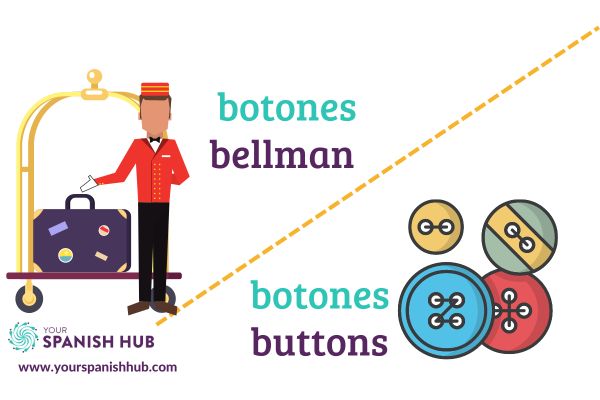
Metro: unidad de medida (meter). La mesa tiene un metro de ancho.
Metro: medio de transporte urbano (subway). Voy a trabajar en metro todos los días.
Pasta: comida (pasta). En Italia se come mucha pasta.
Pasta: dinero (money). Mi tío tiene mucha pasta. Es el dueño de la empresa.
Pegar: golpear (hit). Sarita, no está bien pegar a tu hermano. Pídele perdón.
Pegar: unir con pegamento (glue). Estaba limpiando y se ha caído el jarrón. Se ha roto una parte y la voy a pegar con pegamento.
Pico: herramienta (pick). El obrero necesita un pico para abrir una zanja.
Pico: boca del pájaro (beak). Las especies de aves tienen picos muy diferentes. Esto depende del tipo de alimentación.
Real: perteneciente a la monarquía (royal). Los reyes celebraron una cena en el palacio real.
Real: verdadero (real, true). Tuve una pesadilla que parecía real. ¡Qué mal lo pasé!
Vela: pieza de lienzo de un barco (sail). El próximo sábado vamos a hacer una excursión en un barco de vela.
Vela: cilindro de cera (candle). Me gusta darme un baño con velas aromáticas. Es muy relajante.
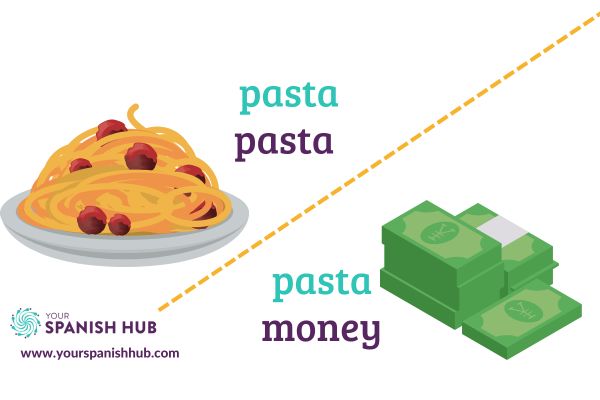
The list of homonyms in Spanish is much longer. Here you have a small sample that, as you progress in your language learning, you will expand with more examples.
Learn to speak fluent Spanish, and learn Spanish in a well-structured way with the guidance of an accredited native teacher. You can take a look at our catalogue of Spanish classes or our Membership Programme.
Book your trial class with us today and meet your teacher.
